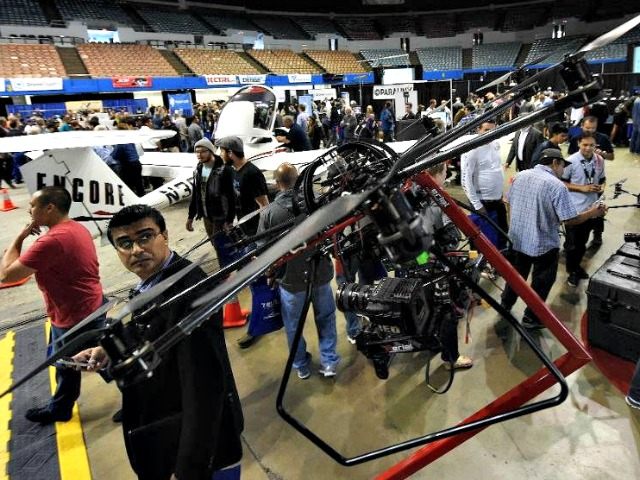The Federal Aviation Administration (FAA) is expected to release its first drone use regulation for commercial drones weighing less than 55 pounds by December 31. The U.S. pioneered drones to the world as disposable machines of war. Unmanned aircraft now film movies, inspect remote portions of the electrical grid, and herd cattle.
The L.A. Memorial Sports Arena just hosted the commercial drone industry’s first business expo, despite the fact that commercially flying drones for profit is still illegal. The new FAA rules may launch a billion dollar American-based industry.
About 95% of unmanned vehicles in 2012, known as drones, were operated by the U.S. military, with a sprinkling from France, U.K., Germany, India, and Israel. But today there are tens of thousands of military drones and several million commercial and personal drones operating around the world. Amazon offers dozens of brands, starting at $50.
The FAA had banned almost all private-sector drone use in the U.S. until it could develop a regulatory structure that could protect people from accidents with the large number of low-flying private planes operating in the U.S. that are at risk from drones. Although the U.S. has the best drone technology, U.S. regulations ban most drone exports to the booming markets around the world.
The FAA two months ago added six film companies permission to use drones, bringing approvals, in a nation of 315 million, to eight commercial drone operations. This compares to the European Union members that have thousands of legal commercial operations. Service-drone.de GmbH out of Berlin has sold more than 400 unmanned aircraft to private-sector companies and is working on a release of its 4th generation device.
There have been serious close calls between drones and passenger jets crossing paths. There are plenty of videos on YouTube about “flyaway” when drones lose Wi-Fi connections or suffer from faulty programming and crash. The FAA also worries that commercial drones using GPS navigation could be hijacked in-air as terrorist weapons.
Iran famously hacked and captured a U.S. ScanEagle drone in December, 2012. Their elite Revolutionary Guard cyber-war team has reverse engineered the spy drone and is now selling the technology to a number of countries that are adversaries to the U.S, including Russia. The head of the Russian air force has stated that Iran intends to mass produce sophisticated drones for export as a symbol of their technical capabilities, according to the semi-official Fars news agency.
U.S. sales are increasing fast as the drones become cheaper, more powerful, and easier to fly. Drone prices start at under $50 on Amazon. DroneFly, in its second year of operations, advertises that they will sell over $9 million in drones in 2013 — its first year of operation. This year, the company is set to triple that.
This month, several thousand people flocked to the L.A. Memorial Sports Arena near USC for the commercial drone industry’s first expo. The all-day event featured the best film shooters and drone flyers Hollywood and action sports media can offer. Top manufactures and experts from Berkeley, Stanford, MIT, and AVUSI gave lectures on new technologies and applications. Dozens of drones flew safely around the arena as head-banger music blared and new video games that incorporate drones launched.
If the FAA draft operating regulations released next week are not too restrictive, America will launch a multi-billion industry. The public will be allowed at least 120 days for comments before the FAA rules become law by publication in the United States Federal Register.
Chriss Street suggests that if you are interested in business and economics, please click on Apple Blamed for Slave Labor, Again.

COMMENTS
Please let us know if you're having issues with commenting.